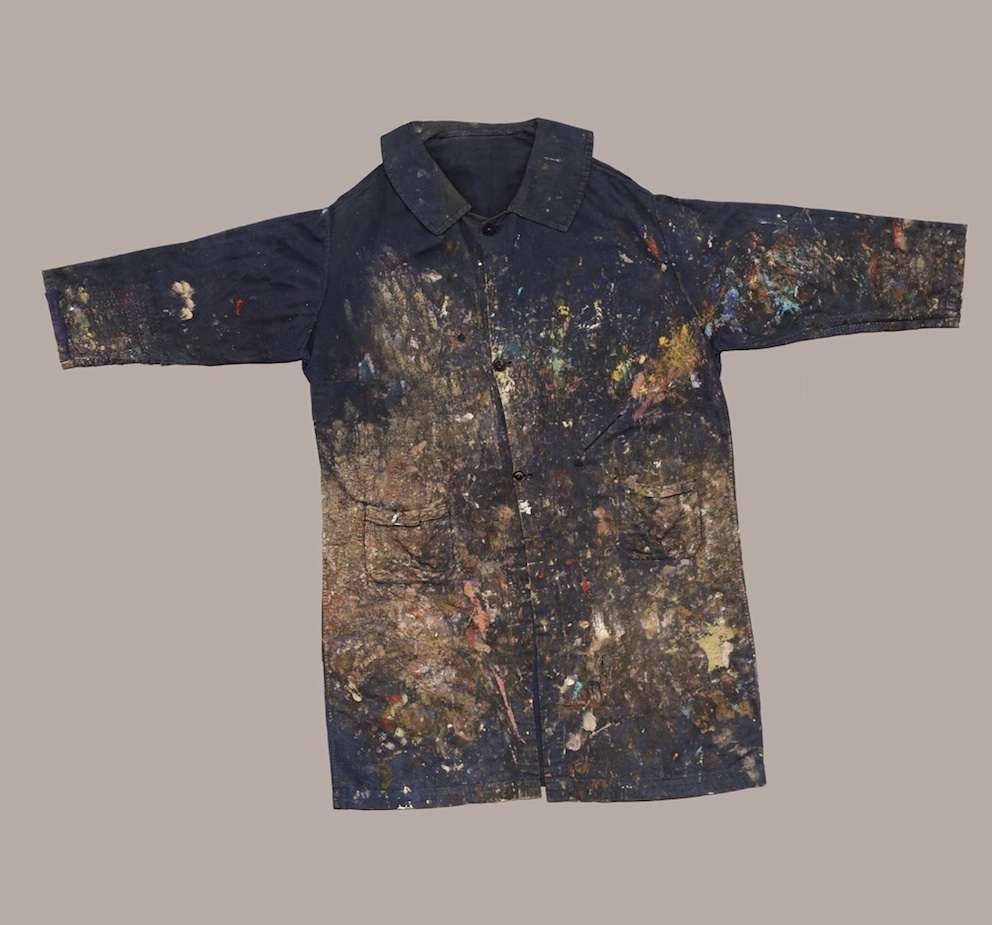Katerina Jebb Scans Balthus at DSM New York
In a recent interview, Comme des Garçons designer Rei Kawakubo explained that she has dedicated the interior design of her new boutique, Dover Street Market New York, to the spirit of outsider art. Presenting a most unexpected alternative to the store’s early Spring ’14 deliveries, Paris-based, British-raised artist Katerina Jebb unveiled her own garment of sorts, with a diptych of a spattered painting smock belonging to the late Polish artist Balthasar Klossowski de Rola (known as Balthus).
Continuing a predominant trajectory in Jebb’s work, the life-size images derive from her painstaking technique of digital scanning—a process in which she has immortalized diverse subjects over the past decade, from high jewelry to the archives of Paris’ Musée Galliera. Stemming from an intimate study of Balthus’ life and works, the images preface a new series to be shown at Tokyo’s Metropolitan Art Museum in April 2014, in a poetically-charged example of archival art, re-contextualizing art history through collective memory and new digital process.
DAN THAWLEY: What were your first memories and impressions of Balthus’ work?
KATERINA JEBB: The first time I ever saw a work by Balthus was a reproduction in a book when I was young and I remember it as being something breathtaking. I felt a sense of relief that the bodily positions of the subjects could exist in someone’s mind and be transposed onto a canvas. I loved the surreal setting of innocence and that the clothes were falling off the body or not at all. There is a conflict of tension and reflection, something indescribable and beyond the realm of language. Looking at the work of Balthus made me understand that words are often unnecessary.
THAWLEY: How did you come to be acquainted with the Klossowski family?
JEBB: I met Harumi Klossowski, the daughter of Balthus, at a dinner 11 years ago and we became friends. I started to visit the Grand Chalet in Switzerland with my children and the project evolved slowly over a number of years.
THAWLEY: Such a project involves a lot of trust. Could you explain your exchange with the object and it’s owners? Also the process itself.
JEBB: Balthus’ family asked me to make an inventory of his possessions, which are essentially the contents of the artist’s studio. He died in 2001 and nothing in the studio has ever been moved since so in essence it’s like a large still life painting. Most of my work is made with a high-resolution scanner and so it followed that I would document the subject using this medium. Balthus wore the same smock to paint in for over 60 years and it was the central piece of his working life. He was obsessed by it, and it seemed to hold more for him than just an ordinary object of clothing. I started by scanning the smock, which is known as “The Tablier.” As the size of the scanner is A3 the work is made in sections that are rendered to form a life-size composition and then digitally retouched to eliminate the traces. The viewer could think the result is one image but in fact it can be as many as 50. I always feel quite haunted by the process of going there and working, the atmosphere is quite charged with poetic energy. The house and the way of life there is quite unlike anywhere else.
THAWLEY: What is the significance for you to install this particular piece in the new DSM NY Space?
JEBB: There is a Balthus exhibition at The Metropolitan Museum, the first in the USA for 30 years. Comme des Garçons invited me to show a work for the opening of DSM and so I proposed the “Tablier of Balthus” that Rei Kawakubo liked and so it’s there on show in all of the magical surroundings of their world.
THAWLEY: Are you able to divulge any new projects you are busy with?
JEBB: I will show more of the scanned objects at The Metropolitan Art Museum Tokyo next April. I’m working on a series about telegrams that is beginning to take shape.
THAWLEY: What do you think of 3D printing and its ramifications in the artistic sphere?
JEBB: Each time there is a new technological discovery it’s normal to want to see what you can make with it. We are living in an age where technology becomes the art form and the artist is a programmer, it is all viable. People want to see a spectacle and 3D printing or whatever new medium provides this. I think new technology is awe-inspiring.
THAWLEY: What is your perspective on photography and reproduction in art today, particularly in your work across many mediums?
JEBB: Photography is omnipresent, 75% of the world is a photographer or filmmaker by definition so it’s a big question. I noticed that people are no longer just looking at natural or manmade phenomena but instead are photographing it, which is quite a different experience. If you were at the top of the Aletsch Glacier looking around and taking in a spectacular vision, the memory could stay with you forever. By photographing the experience instead of just living it there must be a compromise of sorts. I am sort of worried about how many trillions of images exist and are locked inside plastic hard drives with possibly no destination. It’s strange how we now perceive and consume our own memories by storing them and reviewing them throughout our lives. This phenomenon would challenge the natural memory bank where you could compare your true recollection of an event to a digitally derived memory. I used to document my entire life obsessively for years, hundreds of thousands of images which I cannot remember taking because my method was so compulsive. I stopped and now I appreciate being in a situation and not looking at it through a rectangular frame. There is a feeling of ownership to photography, like being a keeper and I wanted to disown this feeling. Photography today is the opium of the masses, which is cool if it gives pleasure to people—but I prefer less of everything.
DOVER STREET MARKET IS LOCATED AT 160 LEXINGTON AVENUE IN NEW YORK, NY 10016. FOR MORE INFORMATION, VISIT THE DSM WEBSITE.







